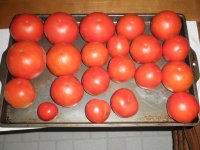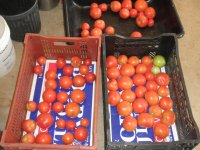Here are some more photos of the fruit from yesterday and today.
Some of the early tomatoes are of medium size but as the season progresses the large (one pound and more) ones will come off.
1st pix--tomatoes on tray picked yesterday.
2nd pix--three containers of tomatoes picked today separated by variety.
3rd pix--a very large cluster of tomatoes.
Anybody got any Miracle Whip?:licking:
Now, start making plans to grow some tomatoes next spring.
Enjoy,
Arkaybee
Some of the early tomatoes are of medium size but as the season progresses the large (one pound and more) ones will come off.
1st pix--tomatoes on tray picked yesterday.
2nd pix--three containers of tomatoes picked today separated by variety.
3rd pix--a very large cluster of tomatoes.
Anybody got any Miracle Whip?:licking:
Now, start making plans to grow some tomatoes next spring.
Enjoy,
Arkaybee


